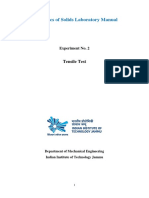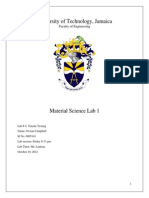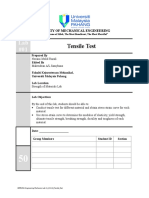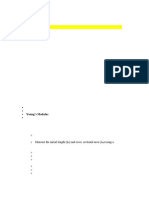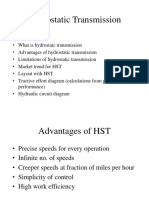Lab Manual 1
Lab Manual 1
Uploaded by
Hallowfied KawsarCopyright:
Available Formats
Lab Manual 1
Lab Manual 1
Uploaded by
Hallowfied KawsarCopyright
Available Formats
Share this document
Did you find this document useful?
Is this content inappropriate?
Copyright:
Available Formats
Lab Manual 1
Lab Manual 1
Uploaded by
Hallowfied KawsarCopyright:
Available Formats
UNIVERSITY OF WINDSOR Faculty of Engineering
Mechanics of Deformable Bodies 85-218
Winter 2012
Experiment 1 Tension Test
Objectives: 1. 2. 3. 4. To carry out quasi-static tension tests on ductile and brittle materials. To determine the mechanical properties of ferrous and non-ferrous materials. To study the behaviour of materials under load. To observe the fracture of specimen.
Equipment: 1. 2. 3. 4. 5. Universal Testing Machine Tinius Olsen Extensometer Tinius Olsen Datascan Analog Measurement Processor Dalite Datascan Configurator Micrometer, scales, dividers, etc.
Specimens: Specimens of ferrous and non-ferrous materials (steel, aluminum and cast iron). Each group should test one specimen of cast iron, one specimen of steel and one specimen of aluminum. Procedure: 1. Measure the diameter of the specimen to be tested at several places along the gauge with a micrometer. Use the average diameter to calculate the cross-sectional area. 2. Examine the punch marks on the specimen to establish the gauge length. 3. Examine the grips in the Universal Testing Machine. Zero the machine for all load ranges to be used. 4. Place the specimen in the grips so that the punch marks face the operator and the grips are properly aligned.
5. Examine the extensometer and attach it to the specimen. Observe the precautions as pointed out by the instructor to avoid damaging the extensometer. 6. Open the Dalite Datascan Configurator. Open defbod1.ovl file and click on the monitor every second window. Check if the load and extend readings are zero. 7. Apply a load of approximately 2 kN to ensure that the extensometer is working properly. If it is working properly reduce the load to zero. 8. Begin to load the specimen slowly. Take readings of elongation in the monitor window at the following load increments: 2 kN increments for cast iron, 4 kN increments for aluminum and steel. In the inelastic range, use elongation increments as the basis of when to take readings. 9. Continue taking readings until the limit of extensometer has been reached, or when rapid increases in elongation are observed. To protect the extensometer from being damaged, the extensometer will be removed at a load of 32 kN for the aluminum specimen, 52 kN for the steel specimen and 20 kN for the cast iron specimen. 10. Observe and record the maximum load and the load at failure on the load window of the Dalite Datascan Configurator. 11. Place the two parts of the specimen together after rupture and measure the total elongation of the gauge. For ductile materials, measure the smallest neck diameter with the micrometer. Observe the appearance of the specimen after failure. 12. Repeat this same procedure for the other specimens to be tested.
Report: Prepare the Lab report according to the outline provided in the course syllabus. This is a formal report that should be written using a word processor; the only hand writing allowed is for the sample calculations. Include the following results in the report: 1. Prepare a table (identical to Data Sheet No.2) for each specimen tested showing the load, elongation, stress and strain. Note that the original cross-sectional area and gauge length are used in these calculations. 2. Plot a graph of the complete stress-strain curve for each specimen. Indicate significant points on the graph. (Stress on the y-axis and strain on the x-axis). It will be necessary to estimate the shape of the curve for portions where the strain was not recorded. 3. For the material which exhibits a yield point, plot a graph showing the elastic portion of the curve, including the yield point, to an enlarged strain scale. 4. Complete Data Sheet No.1. 5. Provide one sample calculation for each mechanical property in Data Sheet No.1 6. Sketch the fracture surface by hand, describe the characteristics of the fracture and comment on the reasons for the fracture, for each specimen tested.
Hints for completing data sheets load original cross - sectional area change in length original length 3. Reduction of area at fracture (%) (original cross = sectional area - final cross - sectional area) original cross 100 - sectional area (final gauge length - original gauge length) original 100 gauge length
1. Stress =
2. Strain =
4. Elongation (%) =
5. Proportional limit is to be obtained from the stress-strain curve. It is the stress at which the stressstain curve is no longer linear. stress
6. Modulus of elasticity = proportional limit.
; it is the slope of the stress-strain curve below the strain
7. Yield stress at 0.2% offset: (see figure)
STRESS (MPa)
Yield stress 3
0 STRAIN 0.002
8. Ultimate Stress (tensile strength) =
maximum load original cross - sectional area
9. Fracture Stress (rupture stress) = 10. Modulus of Resilience
load at fracture original cross sectional area
= energy stored per unit volume at the elastic limit = triangular area under the stress-strain diagram up to the elastic limit 1/2 (proportional limit) (strain at proportional limit) 11. Modulus of Toughness = energy stored per unit volume required to rupture the material = total area under the stress-strain diagram overall average stress strain at rupture
D N M a S p D i
A r e
R e d G a u
E l o P r o M o d Y i e U l t R u p M o d M o d
Data Sheet No. 2 (a) Tension Test Data for Ferrous and NonFerrous Materials Type of Material:
L o
Data Sheet No. 2 (b) Tension Test Data for Ferrous and NonFerrous Materials Type of Material:
L o
Data Sheet No. 2 (c) Tension Test Data for Ferrous and NonFerrous Materials Type of Material:
L o
You might also like
- Tensile Testing of Metals-II (Non-Ferrous Metals) MDDocument3 pagesTensile Testing of Metals-II (Non-Ferrous Metals) MDH S Vishwanath Shastry0% (1)
- 85-218-Lab 2-ManualDocument5 pages85-218-Lab 2-Manualjoseph0% (1)
- Strength of Materials Laboratory ExperimentsDocument20 pagesStrength of Materials Laboratory Experimentskenneth iyahenNo ratings yet
- 3-Exp#03 Tensile TestDocument7 pages3-Exp#03 Tensile TestD7ooM_612No ratings yet
- Experiment 1Document7 pagesExperiment 1waseemjuttNo ratings yet
- MT Lab Experiment 3Document13 pagesMT Lab Experiment 3Himmat Singh RawatNo ratings yet
- Strength of Materia Lab Manual UET, LahoreDocument14 pagesStrength of Materia Lab Manual UET, LahoreRizwan Khurram100% (3)
- Mechanics of Solids Laboratory Manual: Tensile TestDocument8 pagesMechanics of Solids Laboratory Manual: Tensile TestVIPAN KUMARNo ratings yet
- SOM Lab ManualDocument33 pagesSOM Lab Manualsabitaparihar24No ratings yet
- Mos Lab Manual PDFDocument34 pagesMos Lab Manual PDFs.rihanaNo ratings yet
- Tensile Test PresentationDocument36 pagesTensile Test PresentationalkharfaneNo ratings yet
- btech3rd-CE SOM LAB MANUALDocument21 pagesbtech3rd-CE SOM LAB MANUALvkmstp2005No ratings yet
- Som Manual-2013 RegDocument26 pagesSom Manual-2013 RegsugunavidiyadarNo ratings yet
- Som ExperimentsDocument17 pagesSom ExperimentsAnudeex ShettyNo ratings yet
- Laboratory Manual of Tensile TestDocument11 pagesLaboratory Manual of Tensile TestVIPAN KUMARNo ratings yet
- Lab Manual: International Islamic University Malaysia Department of Mechanical EngineeringDocument36 pagesLab Manual: International Islamic University Malaysia Department of Mechanical EngineeringMuhamad HilmiNo ratings yet
- Strength of MaterialDocument18 pagesStrength of MaterialMamta SinghNo ratings yet
- Strength of Materials LabDocument30 pagesStrength of Materials LabDipesh GugaleNo ratings yet
- BME Mannual BT 203-1Document41 pagesBME Mannual BT 203-1shivanshu tiwariNo ratings yet
- Tensile TestDocument6 pagesTensile Testkinwai5557100% (1)
- MEC 222 EXP-Lab-SOMDocument69 pagesMEC 222 EXP-Lab-SOMAbhijeeth NagarajNo ratings yet
- Papua New Guinea University of Technology CE 261-Engineering Materials Test 2 - Tensile Test of A Steel SpecimenDocument4 pagesPapua New Guinea University of Technology CE 261-Engineering Materials Test 2 - Tensile Test of A Steel SpecimenIsrael PopeNo ratings yet
- Lab 1 - Tensile-Testing-2022Document7 pagesLab 1 - Tensile-Testing-2022sahanss2001No ratings yet
- E1 Tensile TestDocument13 pagesE1 Tensile TestFirzana AmiraNo ratings yet
- Manual-1 (A1 To A9)Document37 pagesManual-1 (A1 To A9)Utkarsh AgarwalNo ratings yet
- Tension Test ReportDocument7 pagesTension Test ReportTomy GeorgeNo ratings yet
- SOM Lab ManualDocument32 pagesSOM Lab ManualMuhammad Junaid100% (1)
- Tension TestDocument7 pagesTension TestmanmathkNo ratings yet
- Real O.V Tensile TestingDocument14 pagesReal O.V Tensile TestingOshane ThomasNo ratings yet
- Lab#1 - Tensile Test HandoutDocument7 pagesLab#1 - Tensile Test Handoutgrbxjgsh59No ratings yet
- Theory:: Experiment No. 03 Aim: Shear Test On Mild Steel and Aluminum (Single and Double Shear Tests) Apparatus UsedDocument5 pagesTheory:: Experiment No. 03 Aim: Shear Test On Mild Steel and Aluminum (Single and Double Shear Tests) Apparatus UsedRaj TondayNo ratings yet
- Experiment Name: Tensile Test of Steel: ObjectivesDocument4 pagesExperiment Name: Tensile Test of Steel: ObjectivesKalikiri navyaNo ratings yet
- Laboratory Manual of Tensile TestDocument12 pagesLaboratory Manual of Tensile TestVIPAN KUMARNo ratings yet
- SM Lab ManualsDocument27 pagesSM Lab ManualspraveenampilliNo ratings yet
- Engineering Council Certificate Level Engineering Materials C102 Tutorial 6 - Materials TestingDocument11 pagesEngineering Council Certificate Level Engineering Materials C102 Tutorial 6 - Materials TestingcataiceNo ratings yet
- Tensile Test PresentationDocument36 pagesTensile Test Presentationssdivi100% (3)
- TensileDocument4 pagesTensileاحمد الشلمانيNo ratings yet
- Tensile LabDocument13 pagesTensile LabnevermoreNo ratings yet
- Strain Hardeninig Experement ProcessDocument4 pagesStrain Hardeninig Experement Processmunamak13No ratings yet
- Uniaxial TestDocument6 pagesUniaxial Testanil chejaraNo ratings yet
- Expt 1 Tension TestDocument5 pagesExpt 1 Tension TestRavi ParkheNo ratings yet
- Tensile Test Lab ReportDocument4 pagesTensile Test Lab ReportElisha NissiNo ratings yet
- Material Science and Testing LabDocument26 pagesMaterial Science and Testing LabJitendra JangidNo ratings yet
- 1 Tensile TestDocument12 pages1 Tensile TestVicky NoomNo ratings yet
- Am LabDocument22 pagesAm LabJayavel123No ratings yet
- SOM ExperimentDocument23 pagesSOM ExperimentJitendra SinghNo ratings yet
- Material Testing LabDocument79 pagesMaterial Testing LabBrijesh VermaNo ratings yet
- DK. BMT Lab ManualDocument46 pagesDK. BMT Lab ManualPaviter SinghNo ratings yet
- Lab 5Document7 pagesLab 5amuaz9217No ratings yet
- Experiment # 2 Tension Testing of MetalsDocument3 pagesExperiment # 2 Tension Testing of MetalsJ. Fabián MenaNo ratings yet
- Exp. No 0rdrccc1 Tensile Test of Steel PDFDocument10 pagesExp. No 0rdrccc1 Tensile Test of Steel PDFBCIV008 SushaanNo ratings yet
- Unit - IIIDocument215 pagesUnit - IIINishigandha Bansode100% (1)
- Tensile Test - UTMDocument4 pagesTensile Test - UTMmjayrajsharma19No ratings yet
- التجربة 4 بعد التعديل (1) (1)Document10 pagesالتجربة 4 بعد التعديل (1) (1)yazanabonabhan17No ratings yet
- Advanced Opensees Algorithms, Volume 1: Probability Analysis Of High Pier Cable-Stayed Bridge Under Multiple-Support Excitations, And LiquefactionFrom EverandAdvanced Opensees Algorithms, Volume 1: Probability Analysis Of High Pier Cable-Stayed Bridge Under Multiple-Support Excitations, And LiquefactionNo ratings yet
- Spectral method for fatigue damage estimation with non-zero mean stressFrom EverandSpectral method for fatigue damage estimation with non-zero mean stressNo ratings yet
- Mas DocumentsDocument12 pagesMas DocumentsLorie Grace LagunaNo ratings yet
- ICT Policy 2014 PDFDocument68 pagesICT Policy 2014 PDFGlen Joy GanancialNo ratings yet
- Levels of Confidence in System Dynamics ModelingDocument20 pagesLevels of Confidence in System Dynamics Modelingrebelli100% (1)
- Causes of White Collar CrimesDocument4 pagesCauses of White Collar CrimesKarishma TamtaNo ratings yet
- FXQuasar User ManualDocument2 pagesFXQuasar User ManualAlexandre VassolerNo ratings yet
- SSM Book U5Document17 pagesSSM Book U5geethuramesh1702No ratings yet
- Amigurumi 294spike The DinosaurDocument5 pagesAmigurumi 294spike The DinosaurDra. Alejandra De la Fuente100% (4)
- JPR ProposalDocument4 pagesJPR ProposalVishal Kesharwani100% (2)
- Dipal Ashok Thokale ResumeDocument1 pageDipal Ashok Thokale Resumedipalthokale2000No ratings yet
- Directory PartitionDocument10 pagesDirectory Partitionwajahat baigNo ratings yet
- Yale YK Series Electric WR Operation Manual 2018 April A11867501 Rev AADocument102 pagesYale YK Series Electric WR Operation Manual 2018 April A11867501 Rev AALiam LuntunganNo ratings yet
- Exercise 15Document7 pagesExercise 15vaomaxemNo ratings yet
- 2012 USBSEC Brochure 2Document54 pages2012 USBSEC Brochure 2Jorge GómezNo ratings yet
- Product Manual 03109 (Revision NEW) : 3161 GovernorDocument20 pagesProduct Manual 03109 (Revision NEW) : 3161 GovernorHelen BachtiarNo ratings yet
- XIBO Introduction and Basic OperationDocument18 pagesXIBO Introduction and Basic Operationsteve848130No ratings yet
- SDK Programming GuideDocument606 pagesSDK Programming GuideNatalya Luke100% (2)
- Social MarketingDocument12 pagesSocial MarketingMuhammad Furqan ZebNo ratings yet
- Echegaray Vs Secretary of JusticeDocument12 pagesEchegaray Vs Secretary of JusticeCherry BepitelNo ratings yet
- Sir Uncle Sam by John WhitefordDocument13 pagesSir Uncle Sam by John WhitefordVeristhorne100% (1)
- List of State and Union Territory Capitals in IndiaDocument67 pagesList of State and Union Territory Capitals in Indiaanon_8049111No ratings yet
- Tutorial React NativeDocument117 pagesTutorial React NativeguterioNo ratings yet
- Operation & Maintenance Manual Supplement: Dozer Access SystemDocument19 pagesOperation & Maintenance Manual Supplement: Dozer Access SystemGhassan Ilias AlkikiNo ratings yet
- Masonry 4e l1 CepsDocument31 pagesMasonry 4e l1 Cepsjohn vincentNo ratings yet
- For Data Safety: Written Information Security PlanDocument1 pageFor Data Safety: Written Information Security Planhiamang27No ratings yet
- SACE Emax 2: Instructions For Using Ekip Touch Protection Trip Units and AccessoriesDocument57 pagesSACE Emax 2: Instructions For Using Ekip Touch Protection Trip Units and AccessoriesRisto KuosmanenNo ratings yet
- Busy Association BeckyDocument11 pagesBusy Association BeckySamuel L ENo ratings yet
- Disney Research Paper Generators FinalDocument8 pagesDisney Research Paper Generators Finaljanaaidaas1996No ratings yet
- TOPIC 2 - Classification of CompanyDocument24 pagesTOPIC 2 - Classification of CompanyShahrizatSmailKassimNo ratings yet
- HST TrainingDocument11 pagesHST TrainingRamesh BabuNo ratings yet
- Machine Learning Based Spam E-Mail DetectionDocument10 pagesMachine Learning Based Spam E-Mail Detectionghazy almutiryNo ratings yet







